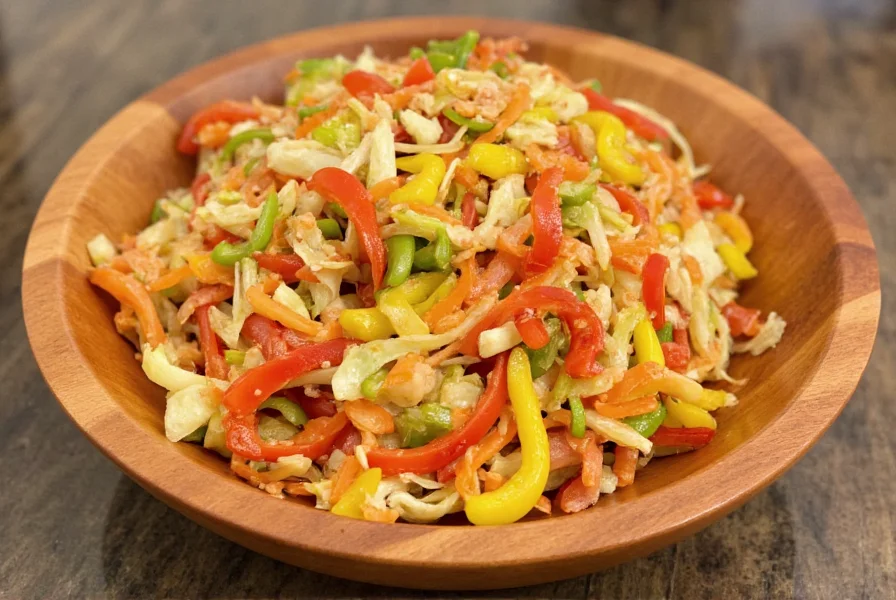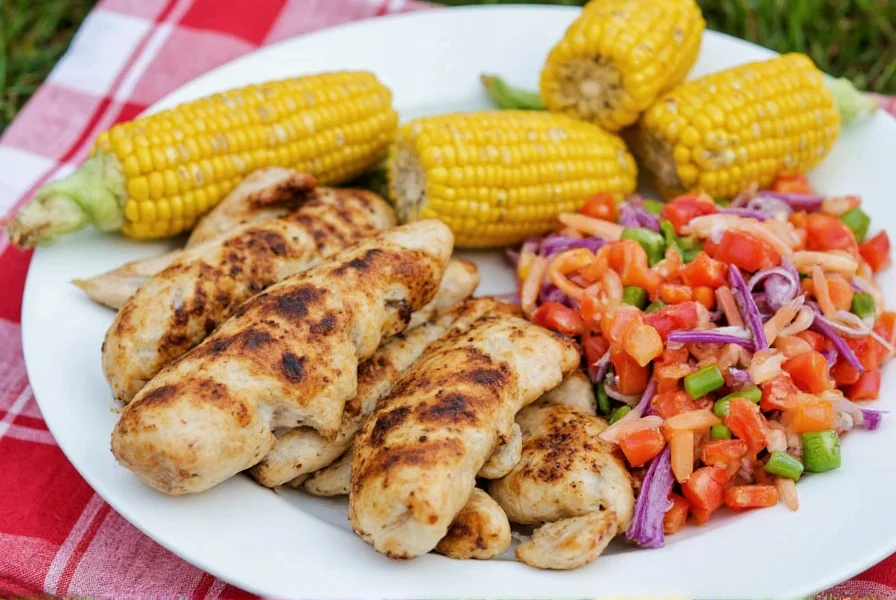When searching for how to make pepper slaw recipe, home cooks discover a versatile dish that transforms ordinary meals with its crisp texture and bright flavors. Unlike traditional coleslaw which relies primarily on cabbage, pepper slaw incorporates multiple varieties of bell peppers—red, yellow, and orange—which contribute natural sweetness and a spectrum of vitamins including substantial amounts of vitamin C and antioxidants.
What Exactly Is Pepper Slaw?
The pepper slaw vs coleslaw difference lies in the starring ingredients. While coleslaw traditionally features cabbage as the dominant component with minimal other vegetables, pepper slaw elevates bell peppers to equal or even primary status. This creates a more complex flavor profile with natural sweetness that balances beautifully with tangy dressings.
Historically, slaw variations have evolved across cultures, with Dutch origins ("koolsla" meaning cabbage salad) that later adapted to regional preferences. Pepper slaw emerged as cooks sought more colorful, nutrient-dense alternatives to traditional recipes, particularly gaining popularity in American Southern cuisine and barbecue culture where its bright appearance complements smoked meats.

Essential Ingredients and Their Benefits
The magic of best peppers for slaw recipe comes from selecting the right combination of ingredients:
| Ingredient | Recommended Quantity | Key Benefits |
|---|---|---|
| Red bell peppers | 1 large, julienned | Highest in vitamin C and lycopene; adds sweetness |
| Yellow bell peppers | 1 large, julienned | Milder flavor, rich in vitamin A |
| Green cabbage | 3 cups shredded | Provides crunch and fiber foundation |
| Carrot | 1 medium, grated | Adds color contrast and natural sweetness |
| Red onion | 1/4 cup thinly sliced | Provides sharp contrast and depth |
Classic Pepper Slaw Recipe
This straightforward quick pepper slaw side dish recipe yields approximately 6 servings and requires just 20 minutes of preparation time:
Dressing Ingredients
- 1/4 cup apple cider vinegar
- 3 tablespoons olive oil or avocado oil
- 2 tablespoons honey or maple syrup
- 1 tablespoon Dijon mustard
- 1 teaspoon celery seeds
- 1/2 teaspoon garlic powder
- Salt and freshly ground black pepper to taste
Assembly Instructions
- Prepare vegetables: Julienne 1 red and 1 yellow bell pepper into thin strips. Shred 3 cups of green cabbage. Julienne 1/4 red onion. Grate 1 medium carrot.
- Whisk dressing: In a small bowl, combine vinegar, oil, honey, mustard, celery seeds, garlic powder, salt and pepper. Whisk until emulsified.
- Combine: In a large bowl, toss all vegetables with the dressing until evenly coated.
- Rest: Cover and refrigerate for at least 30 minutes (ideally 2 hours) to allow flavors to meld and vegetables to soften slightly.
- Serve: Stir gently before serving. Adjust seasoning if needed.
Popular Variations for Every Occasion
Adapt your pepper slaw with vinegar dressing to suit different dietary needs and flavor preferences:
Regional Twists
- Mexican-Inspired: Add jalapeño slices, cilantro, and lime juice; substitute red cabbage for green
- Asian Fusion: Use rice vinegar dressing with sesame oil, ginger, and soy sauce; add mandarin orange segments
- Southern BBQ Style: Incorporate apple chunks and a touch of liquid smoke; serve alongside pulled pork
Dietary Adaptations
- Vegan: Use maple syrup instead of honey in the dressing
- Low-Sugar: Omit sweetener and increase vinegar slightly; add cucumber for freshness
- Creamy Version: Replace vinegar dressing with Greek yogurt base for a richer texture

Serving Suggestions and Perfect Pairings
Understanding colorful pepper slaw for summer BBQs helps maximize its culinary potential. This versatile side complements numerous main dishes:
- Grilled Meats: Perfect counterpoint to rich barbecue flavors—try with pulled pork sandwiches or grilled chicken
- Seafood: Excellent alongside fish tacos or grilled shrimp skewers
- Veggie Bowls: Adds crunch and color to grain bowls and Buddha bowls
- As a Topping: Elevates burgers, sandwiches, and even fish tacos with its refreshing crunch
For meal prep enthusiasts, pepper slaw maintains quality better than traditional coleslaw due to the peppers' firmer texture. It typically stays crisp for 3-4 days when stored properly in an airtight container.
Nutritional Advantages Over Traditional Coleslaw
The healthy pepper slaw dressing ideas contribute to this dish's nutritional superiority. Compared to mayonnaise-based coleslaws, vinegar-dressed pepper slaw typically contains:
- 50-75% fewer calories per serving
- Significantly less fat (especially saturated fat)
- Higher vitamin C content (peppers contain nearly triple the vitamin C of cabbage)
- Additional carotenoids from colorful peppers that support eye health
- Natural prebiotic fibers that support gut health
Common Mistakes to Avoid
Even experienced cooks can stumble when preparing gluten-free pepper slaw recipe. Watch for these pitfalls:
- Overdressing: Start with 3/4 of the dressing and add more as needed—vegetables will release liquid as they sit
- Insufficient Rest Time: Rushing to serve immediately results in harsher flavors; minimum 30 minutes chilling is essential
- Using Waxed Bell Peppers: Always wash peppers thoroughly to remove wax coating which can affect texture
- Incorrect Cutting Technique: Julienne (thin matchstick cuts) rather than dicing ensures proper texture integration
- Adding Salt Too Early: Salt draws out moisture—add just before serving for maximum crunch
Storage Guidelines for Maximum Freshness
Proper storage ensures your pepper slaw maintains its signature crunch. Store in an airtight container in the refrigerator for up to 4 days. For best results:
- Place a paper towel at the bottom of the container to absorb excess moisture
- Keep dressing separate if meal prepping for more than 2 days
- Avoid freezing, as the high water content in peppers causes texture degradation
- Stir gently before serving to redistribute dressing without crushing vegetables
Conclusion: Why Pepper Slaw Deserves a Place at Your Table
Pepper slaw represents the perfect marriage of nutrition, flavor, and visual appeal. Its versatility across cuisines and dietary preferences makes it an indispensable addition to any cook's repertoire. Whether you're hosting a summer barbecue or preparing weekday lunches, this vibrant side dish delivers crunch, color, and a nutrient boost that traditional coleslaw simply can't match. The pepper slaw vs coleslaw difference ultimately comes down to personal preference, but those who try pepper slaw often find themselves reaching for it repeatedly thanks to its superior balance of sweet, tangy, and crisp elements.
Frequently Asked Questions
Can I make pepper slaw ahead of time?
Yes, pepper slaw actually improves when made 2-4 hours ahead as the flavors meld. For best texture, add the dressing no more than 4 hours before serving. Store in an airtight container with a paper towel at the bottom to absorb excess moisture. Properly stored, it maintains crispness for 3-4 days.
What's the best way to cut peppers for slaw?
The ideal technique is julienne cutting—slicing peppers into thin matchstick strips about 1/8 inch thick. First remove seeds and membranes, then cut the pepper into quarters. Lay each quarter flat and make lengthwise slices, then rotate and slice crosswise to create uniform strips. This method preserves crunch while ensuring even dressing distribution.
How can I prevent my pepper slaw from getting soggy?
To maintain maximum crunch: 1) Salt cabbage separately first and let drain for 15 minutes before adding other ingredients, 2) Use a vinegar-based dressing rather than creamy dressings which break down faster, 3) Store dressing separately if preparing more than 2 hours ahead, 4) Place a paper towel in the storage container to absorb excess moisture, and 5) Add salt just before serving rather than during preparation.
Can I use other vegetables in pepper slaw?
Absolutely! While bell peppers and cabbage form the foundation, many variations include shredded carrots, thinly sliced fennel, jicama, or snap peas. For added texture, consider toasted sunflower seeds or chopped pecans. Just maintain the 2:1 ratio of crunchy vegetables to dressing to preserve the signature slaw texture.
Is pepper slaw suitable for special diets?
Yes, pepper slaw naturally accommodates many dietary needs. It's inherently gluten-free, vegan (with maple syrup instead of honey), and can be made sugar-free by omitting sweeteners. For paleo or Whole30 diets, use compliant sweeteners or increase natural sweetness with apple chunks. The vinegar-based dressing makes it lower in calories and fat than traditional coleslaw, appealing to those watching their weight.











 浙公网安备
33010002000092号
浙公网安备
33010002000092号 浙B2-20120091-4
浙B2-20120091-4